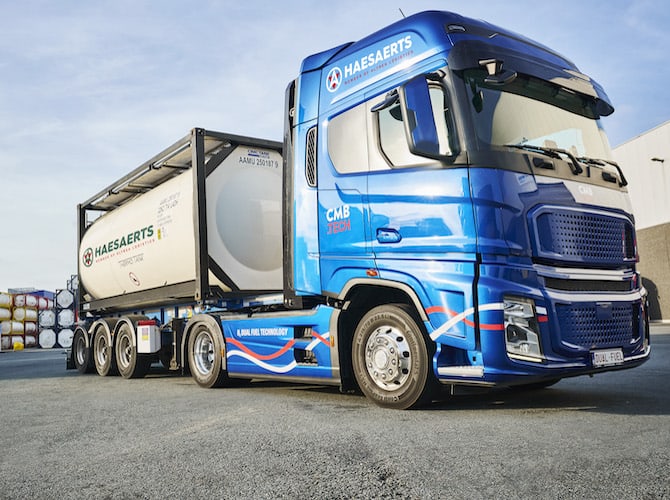The transport industry accounts for about a quarter of global greenhouse emissions. Luxembourg innovator and tech pioneer in decarbonising haulage Haesaerts recently rolled out a new version of its dual fuel truck solution in the grand duchy. CEO Luc Haesaerts talks about disrupting the industry.
Please tell us a bit about the background of Haesaerts?
Haesaerts is a family-owned business with 123 years’ experience in the industry. It became part of the Altrea group in 2019. The group has 14 companies connected with transport and logistics, active in eight countries with the headquarters in Belgium. Half of our work is focused on packed products and the other half is in tank transportation, so chemical liquids, gases, cryogenics, which are transported intermodally in tankers and tank containers, via a combination of trucks, trains or ships. We have 700 trucks and 2,000 transport units, like tractors.
What is the 2.1 dual fuel truck solution and what are the emission savings compared to regular diesel trucks?
Our partner, CMB.Tech, took a standard diesel driven truck from the production line and retrofitted hydrogen to create a dual fuel truck. The 2.0 dual fuel truck is fuelled 80% hydrogen and 20% diesel, bringing 80% emission reductions. On 14 September, we unveiled the 2.1 version, which consumes 80% hydrogen and 20% hydrated vegetable oil (HVO), which is a much cleaner fuel, and can perfectly replace today’s diesel. By replacing diesel with HVO, CO2 is reduced by 98%.
What has been the response from customers to your dual fuel trucks?
There is very good traction from the industry because they will be obliged to report the emissions of the logistics even if it is done by external parties. And from the end results they will have to pay emission rights.
The timing of the new truck coincides with the announcement of Luxembourg’s first hydrogen refuelling station, to open in 2023. How important is the station for your company’s dual fuel trucks to serve its current network?
The refuelling station is in a very strategic location, on the north-south corridor, which is one of the most-used logistics corridors in Europe. We are very actively present there and in large volumes.
The main activity of Bettembourg in transport is the huge intermodal railroad terminal there. The fuel station is on the same platform. So when a long distance cargo comes in by train, it is then transferred onto a truck for local delivery. And if we can then use a hydrogen truck for that local delivery, then that is the next step in emission reduction.
The autonomy of our vehicle is 400 kilometers and then it must refuel on hydrogen. Our group operates 300 transits a week to Luxembourg by truck. From Bettembourg, if the next or the previous fuel station is within a range of less than 400 kilometres, it means that you can refuel and continue. For example, we can refuel on hydrogen today in Antwerp, stop by in Luxembourg, and the French have planned a hydrogen refuelling station in the region of Metz-Nancy, and from there then you’re in Lyon.
To assist the transition to hydrogen fuelled haulage, what needs to happen in Luxembourg?
In my mind, Luxembourg could have three, maybe four hydrogen fuel stations. We’ve strong corridors, for example on the A3 and A6 motorways. After the press conference on 14 September, there was an informal talk about the second station, which would be modelled on Bettembourg’s, i.e. a location with good infrastructure for diesel trucks, HVO and hydrogen.
The government can play a role by giving a lease or concession on a piece of land connected to the motorway. At the end of the year, the government will announce a subsidy for heavy goods vehicles, similar to the low emission subsidies offered to car and van owners.
How else is the group using technology in its operations?
We own what we call chemical support centres, where we can store, distribute and handle chemicals. We have a large facility to store tank containers and to cover that we have a control tower, a digital tool that has a helicopter view over long journeys. It gives the customer an online insight and through its algorithms, makes a prognosis as to whether the supply is in line with the consumption.

What other tech projects and announcements has Haesaerts got planned?
There is more in the pipeline to decarbonise and transfer chemical supplies to Luxembourg from too short distances to railroad, a combination that until now was not economically realistic. In December, in Bettembourg, we will launch a solution for chemicals being delivered in Luxembourg over shorter distances.
When you combine rail and road, to make the journey cost effective, the minimum distance travelled must be 1000 kilometres. We have redesigned the transportation tanks so that we can increase the payload for local delivery and we have obtained a special permit for that vehicle. If you go to 100% efficiency of a rail wagon, payload is higher than the best possible truck today. The tank containers containing liquid, in this case, are sized for the maximum capacity of the track. So we have developed a size that matches the maximum capacity of the wagon. We’ve made improvements to weight and, with government, obtained a special permit. We started this project 18 months ago as part of the Neistart Letzebuerg call for projects.
